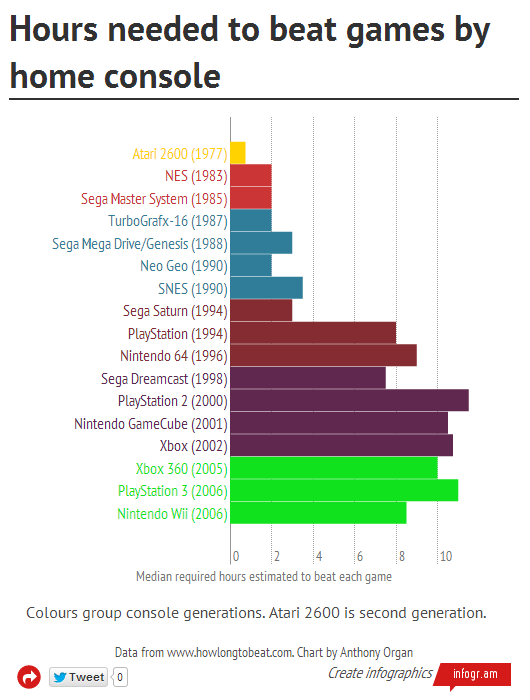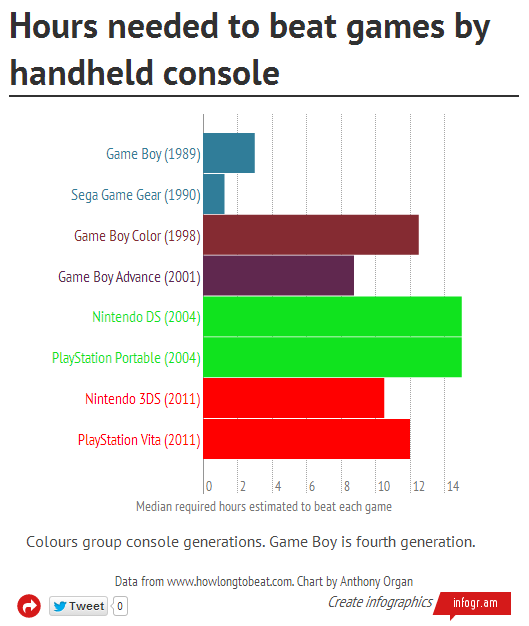Value for money in the games industry has been in the spotlight recently. Wading into the debate this week was Adrian Chmielarz, former creative director at People Can Fly, the studio behind the critically acclaimed, though undersold, Bulletstorm.
He thinks that charging “$60 for a game is a little insane” and said that developers are obliged to pad things out with filler to justify the prices. He argued that lowering development costs and making games just as long as they need to be would be better for everyone.
This made me wonder how much longer games are now than they used to be. With bigger worlds cropping up all the time, it can be possible to spend months in some games without discovering everything.
Fortunately, there’s a great site called HowLongToBeat where people submit estimates of how long different play styles take, ranging from just finishing the story to collecting everything you possibly can.
I’ve scraped the estimates to see how the length of games has been changing.
Notes:
- The site’s database spans nearly 19,000 games, but not all have estimates. Once I removed all the entries without data, I was left with 8,360 entries.
- For the analysis, I’ve used the “Combined” estimate for each game, which is the average of all of the estimates for each play style.
- I’ve also used the median instead of the average, because it’s much better.
Release Dates:
First I broke up the data based on the year in which each game was released.
As you can see from the graph, the length of games seemed to increase pretty dramatically across the 1990s. In the ten years between 1989 and 1999, the time you’d have to invest into a game skyrocketed 350 per cent from 2.5 hours to 11.25 hours.
This makes sense given the technology advances at the time, which allowed the development of games which simply would have been impossible before.
What’s really interesting though is that the early 2000s seemed to be a peak, with games actually becoming shorter from 2007 onwards.
On first glance, this would suggest that they may not be as packed with filler as Chmielarz makes out.
Home Consoles:
I next looked at how the length of games differed when broken down by home console.
As we gathered from the previous graph, it was during the fifth generation of consoles in the 1990s that games started becoming much longer.
It’s interesting to see that the Sega Saturn, part of the same generation, missed out on the longer games. It’s worth noting though that many developers found it more difficult to work with than the PlayStation or Nintendo 64, so perhaps they just weren’t able to take full advantage of its improved technology.
Also, we see that the length of games did seem to peak during the sixth generation, with games on the next three consoles taking less time to beat than on their predecessors.
The decline was sharper in the first graph because the growth of mobile gaming and shorter downloadable titles from services like Xbox Live Arcade, which are not included here.
Handheld consoles:
I also looked at how the length of games on handheld consoles has developed.
The first thing to note is that handheld games generally have longer play times than console games. They also benefitted from the same 1990s boom in game length which we saw in the home consoles.
Even so, the latest generation seems to have produced some slightly shorter games, which is a continuation of the trend we have been seeing throughout. This is better news for our battery lives at least!
Conclusion:
So it seems that the trend of making games longer and longer may actually have been reversing slightly over the past console generation.
Perhaps Chmielarz is still right though in his belief that developers should consider focusing resources into shorter, quality games as opposed to filling them with filler.
It would be interesting if there were a way to measure how much of a game is “filler” and to track it over time in a similar way to what has been done here.
What is considered “filler” would be pretty subjective though and measuring it would be a tricky task.



Excellent write up, Anthony.
I couldn’t agree more with Chmielarz in the sentiment that charging $60 for a title in today’s market is absolutely insane. It made somewhat sense back in the days of SNES when a cartridge consisted of plastic and various other components along with budding technology, but not so much when discs and digital downloads are the primary avenues of distribution.
I agree with the idea that game developers of tomorrow need to be concerned with providing a solid experience, whether single player or multiplayer, than trying to make a game last twice as long with not so wonderful filler content.
Once procedural content generation, whether it’s level design or character interaction, becomes the norm a lot of developers will likely no longer have the need to create filler because procedural equals infinite replay value.
Back to the point at hand.. great work, Anthony!
LikeLike
The stats seem a bit misleading. They appear to take a bunch of games and blindly take an average.
Seriously look at the short games. Pinball, at 9 minutes. Battle Colosseum at 10 minutes. Browse the <30m crowd and you'll see a bunch of short-session games that are designed to be short.
Dr. Mario, Pinball, and PvP Melee are all short games. But they are games you replay thousands of times.
The Final Fantasy and Elder Scrolls and Dragon Quests are long games. You might replay them once or twice, but that's it.
But the site lumps the 5 minute Dr. Mario style games with the 60 hour Dragon Quest style games since they both came on the same console, then reports an average play time is 2 hours. That is a far less valuable statistic. It tells more about the style of games (many short games instead of many long games) rather than the length within a genre.
LikeLike
These days I prefer shorter games simply because, as a freelancer, I have much less time available for playing. 😦
LikeLike
A breakdown by genre through the years would be great too!
I’m sure we could see some interesting patterns in some genres.
LikeLike
This was something I wanted to look at originally, but I decided against it because you can often get crossovers of genre. I might try and find a way to make it work though.
Something I do want to do is look at how certain games series have evolved.
LikeLike
Its actually quite worrying how the playablilty of games has decined, mainly to focus on multiplayer, especially when half of the gaming community are fed up it and just want to relax when playing a single player game
LikeLike